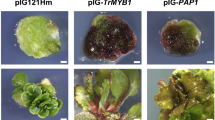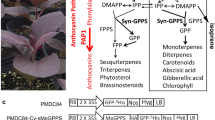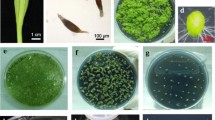Abstract
Carnation (Dianthus caryophyllus L.) is one of the most important ornamental plants in the world. Though morphological modification of carnation is very important to its commercial value, there have been no relevant reports until now. PttKN1 (Populus tremula × Tremuoides knotted1), isolated from the vascular cambial region of hybrid aspen, is a novel member of KNOX gene family. In this paper, we transformed 35S:PttKN1 to carnation via Agrobacterium tumefaciens. All primary transformants subsequently obtained were placed into phenotypic categories and self-pollinated. A total of 32 T0 progeny with aberrant phenotypes were obtained. PCR assay proved the validity of these transgenic plants. Phenotypes of 32 35S:PttKN1 plants were distinct from those of wild-type plants, including: (1) modification of phyllotaxis (15/32): wild-type carnation was with typical opposite phyllotaxis, while transgenic plants displayed tricussate whorled and multiple-cussate whorled phyllotaxis. Irregular modification of phyllotaxis was also observed; (2) modification of stem (9/32): wild-type stems were round; however, some transgenic plants exhibited much thicker and flatter stem; (3) the whole transgenic plants of carnation (8/32) became dwarf. These morphological modifications of carnation indicate that we have successfully attained some novel lines of carnation. These lines can have potential practical applications. In conclusion, the selection of stably genetic lines is discussed.





Similar content being viewed by others
References
Amaya I, Ratcliffe OJ, Bradley DJ (1999) Expression of CENTRORADIALIS (CEN) and CEN-like genes in tobacco reveals a conserved mechanism controlling phase change in diverse species. Plant Cell 11:1405–1418
Baum SF, Rost TL (1996) Root apical organization in Arabidopsis thaliana: root cap and protoderm. Protoplasma 192:178–188
Bovy AG, Agenent GC, Dons HJM, Van AC (1999) Heterologous expression of the Arabidopsis etrl-1 allele inhibits the senescence of carnation flowers. Mo1 Breed 4:301–308
Casanova E, Zuker A, Trillas MIM, oysset L, Vainstein A (2003) The rolC gene in carnation exhibits cytokinin and auxin-like activities. Sci Hortic 97:321–331
Chuck G, Lincoln C, Hake S (1996) KNAT1 induces lobed leaves with ectopic meristems when overexpressed in Arabidopsis. Plant Cell 8:1277–1289
Cuellar S, Bilbao O, Castro C, Nustez C, Rodriguez LE, Mosquera T (1999) Evaluation of the phenotypic characteristics of F1 hybrids from crosses involving 10 carnation varieties (Dianthus caryophyllus L.). Acta Hortic 482:291–297
Frey L, Janick J (1991) Organogenesis in carnation. J Am Soc Hortic Sci 116:1108–1112
Fuchs C (1963) Fuchsin staining with NaOH clearing for lignified elements of whole plants or plant organs. Stain Technol 38:141–144
Galun E, Breiman A (1997) Transgenic plants. Imperial College Press, London
Grant GE, Thomson LMJ, Pither-Joyce MD, Dale TM, Cooper PA (2003) Influence of Agrobacterium tumefaciens strain on the production of transgenic peas (Pisum sativum L.). Plant Cell Rep 21:1207–1210
Ha CM, Jun JH, Nam HG, Fletcher JC (2007) BLADE-ON-PETIOLE1 and 2 control Arabidopsis lateral organ fate through regulation of LOB domain and adaxial–abaxial polarity genes. Plant Cell 19:1809–1825
Hansen G, Wright MS (1999) Recent advances in the transformation of plants. Trends Plant Sci 4:226–231
Hu X, Wu QF, Xie YH, Ru H, Xie F, Wang XY et al (2005) Ectopic expression of the PttKN1 gene induces alterations in the morphology of the leaves and flowers in Petunia hybrida Vilm. J Intergr Plant Biol 47(10):1153–1158
Jaligot E, Rival A, Beule T, Dussert S, Verdeil JL (2000) Somaclonal variation in oil palm (Elaeis guineensis Jacq.): the DNA methylation hypothesis. Plant Cell Rep 19:684–690
Kosugi YW, Aki K, Lwazaki Y (2002) Senescence and gene expression of transgenic non-ethylene-producing carnation flowers. Jpn Soc Hortic Sci 71:638–642
Lu CY, Nugent G, Wardley-Richardson T, Chandler SF, Young R, Dalling MJ (1991) Agrobacterium-mediated transformation of carnation (Dianthus caryophyllus L.). Biotechnology 9:864–868
Meng LS, Ding WQ, Hu X, Wang CY (2009) Transformation of PttKN1 gene to cockscomb. Acta Physiologiae Plantarum 31:683–691
Nadolska-Orczyk A, Orczyk W (2000) Study of the factors influencing Agrobacterium-mediated transformation of pea (Pisum sativum L.). Mol Breed 6:185–194
Nakano M, Hoshino Y, Mii M (1994) Adventitious shoot regeneration from cultured petal explants of carnation. Plant Cell Tissue Organ Cult 36:15–19
Savin KL, Baidoette SC, Graham MW (1995) Antisense ACC oxidase RNA delays carnation petal senescence. HortScience 30:970–972
Sinha NR, Williams RE, Hake S (1993) Overexpression of the maize homeobox gene, KNOTTED-1, causes a switch from determinate to indeterminate cell fates. Genes Dev 7:787–795
Staby GL, Robertson JL, Kiplinger DC, Conover CA (1976). In: Proc Natl Floricult Conf. Columbus, Ohio, pp 1–77 cited from: Larson RA, ed (1980) Introduction to Floriculture, Academic Press Inc. New York, pp 47–57
Staby GI, Robertson JL, Kiplinger DC, Conover CA (1978) Chain of life. Ohio Florists Assoc. Ohio State University, Columbus
Tanaka Y, Tauda S, Kusumi T (1998) Metabolic engineering to modify flower color. Plant Cell Physiol 11:1119–1126
Tanaka K, Kanno Y, Kudo S, Suzuki M (2000) Somatic embryogenesis and plant regeneration in chrysanthemum (Dendranthema grandiflorum (Ramat.) Kitamura). Plant Cell Rep 19:946–953
Tanaka Y, Katsumoto Y, Brugliera F, Mason J (2005) Genetic engineering in floriculture. Plant Cell Tissue Organ Cult 80:1–24
Winefield C, Lewis D, Arathoon S, Deroles S (1999) Alteration of petunia plant from through the introduction of the rolC gene from Agrobacterium rhizogenes. Mol Breed 5:543–551
Woodson WR, Lawton KA (1988) Ethylene-induced gene expression in carnation petals. Plant Physiol 87:498–503
Yantcheva A, Vlahova M, Antanassov A (1998) Direct somatic embryogenesis and plant regeneration of carnation (Dianthus caryophyllus L.). Plant Cell Rep 18:148–153
Zuker A, Ahroni A, Tzfira T, Hagit BM, Vainstein A (1999) Wounding by bombardment yields highly efficient Agrobacterium-mediated transformation of carnation (Dianthus caryophyllus L). Mol Breed 5:367–375
Zuker A, Tzfira T, Scovel G (2001) RolC-transgenic carnation with improved horticultural traits: quantitative and qualitative analyses of greenhouse-grown plants. J Am Soc Hortic Sci 126:13–18
Acknowledgments
The authors thank Dr. Olof Olsson (Göteborg University, Göteborg, Sweden) for providing the plasmid containing 35S:PttKN1. This research was supported by the Natural Science Foundation of China (Grant No. 30470863).
Author information
Authors and Affiliations
Corresponding author
Additional information
Communicated by L.A. Kleczkowski.
The authors L.-S. Meng and J.-P. Song contributed equally to this work.
Rights and permissions
About this article
Cite this article
Meng, LS., Song, JP., Sun, SB. et al. The ectopic expression of PttKN1 gene causes pleiotropic alternation of morphology in transgenic carnation (Dianthus caryophyllus L.). Acta Physiol Plant 31, 1155–1164 (2009). https://doi.org/10.1007/s11738-009-0334-z
Received:
Revised:
Accepted:
Published:
Issue Date:
DOI: https://doi.org/10.1007/s11738-009-0334-z




